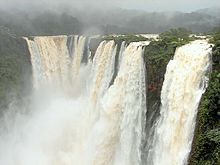

This article needs additional citations for verification. Please help improve this articlebyadding citations to reliable sources. Unsourced material may be challenged and removed.
Find sources: "Jog Falls" – news · newspapers · books · scholar · JSTOR (December 2022) (Learn how and when to remove this message) |
| Jog Falls | |
|---|---|
| Joga Jalapatha Jogada gundi(pit) | |

Jog Falls
| |
 | |
| Location | Jog Fall,[4][5] Karnataka, India |
| Type | Cataract, Segmented |
| Elevation | 488 m (1,601 ft) |
| Total height | 253 m (830 ft)[1] |
| Number of drops | 4 (Raja (king), Rani (queen), Roarer, Rocket)[2] |
| Longest drop | 254 m (833 ft) |
| Average width | 472 m (1,549 ft) |
| Watercourse | Sharavati River[3] |
| Average flow rate | 153 m3/s (5,400 cu ft/s) |
Jog Falls[6] is a waterfall on the Sharavati river located in Siddapur taluk,[7] Uttara Kannada District[8] and its view point is located in Sagara taluk, Shimoga district of Karnataka, India.[9] It is the second highest plunge waterfall in India.[10] It is a segmented waterfall which depends on rain and season to become a plunge waterfall. The falls are major attractions for tourists and is ranked 36th in the list of free-falling waterfalls, 490th in the world by list of waterfalls by total height, 128th in the list of single-drop waterfalls in the World by the waterfall database.[11]
Jog Falls is created by the Sharavati river dropping 253 m (830 ft), making it the third-highest waterfall in India after the Nohkalikai Falls with a drop of 335 m (1,099 ft) in Meghalaya[12] and the Dudhsagar Falls with a drop of 310 m (1,020 ft) in Goa.
Sharavathi, a river which rises at Ambutirtha, next to Nonabur, in the Thirthahalli taluk takes a northwesterly course by Fatte petta, receives the Haridravati on the right below Pattaguppe and the Yenne Hole on the left above Barangi. Then, it bends to the west, precipitates itself down the Jog Falls (aka Gersoppa Falls), and passes the village of Gersoppa (properly Geru-Sappe), which is some 30 kilometres (19 mi) away, discharging into the Arabian Sea at Honnavar in Uttara Kannada.
The Sharavathi, flowing over a very rocky bed about 250 yards (230 m) wide, reaches a tremendous chasm, 290 m (950 ft) deep, and the water comes down in four distinct falls, Raja, Rani, Roarer and Rocket.[13] The Raja Fall comes down in one unbroken column sheer to the depth of 250 m (830 ft). Halfway down, it is encountered by the Roarer, which precipitates itself into a vast cup and then rushes violently downwards to meet the Raja. The Rocket shoots downwards in a series of jets. The Rani moves quietly over the mountainside in a sheet of foam. The Tourism Department has built steps from the viewpoint at the top, where the waterfall can be seen from across, to the bottom of the hill. There are approximately 1,400 steps made to reach the bottom of the hill.[14]

Associated with the waterfall is the nearby Linganamakki Dam across the Sharavati River.[15] The power station has been operational since 1948 and is of 120 MW capacity, one of the largest hydroelectric stations in India at that time and a small source of electric power for Karnataka now. The power station was previously named Krishna Rajendra hydro-electric project, after the King of Mysore at that time. The name was later changed to Mahatma Gandhi Hydro-electric Project. It was served by The Hirebhaskara dam until 1960. After 1960, due to the ideas of Mokshagundam Visvesvarayya, Linganmakki Dam has been used for power generation.[16]
The hydro-electric project was conceived by the government of Mysore in mid-1943. A scheme to generate 64,000 horsepower at a cost of ₹358 lakh was designed.[17] The Power House on the right bank of the Gerusoppa dam consists of four Francis-type turbines coupled to the generating units of 60 MW each. The units are configured to operate at a design head of 47.5 mtrs. An outdoor switchyard is located between the toe of the dam and the power house. Power from the outdoor yard is evacuated through a 220 KV double circuit transmission line connected to the state grid at Talaguppa.
The capacity was increased subsequently and currently generates 240 MW of power.[18]

Jog Falls is situated Near Siddapura And Sagara city.
133 km (83 mi)
|
| |
|---|---|
| Geology |
|
| Heritage |
|
| Landforms |
|
| Regions |
|
| Subdivisions |
|
| Environment and climate |
|
| See also |
|
|
Shimoga district topics
| |
|---|---|
| History |
|
| Taluks |
|
| Rivers |
|
| Tourist places |
|